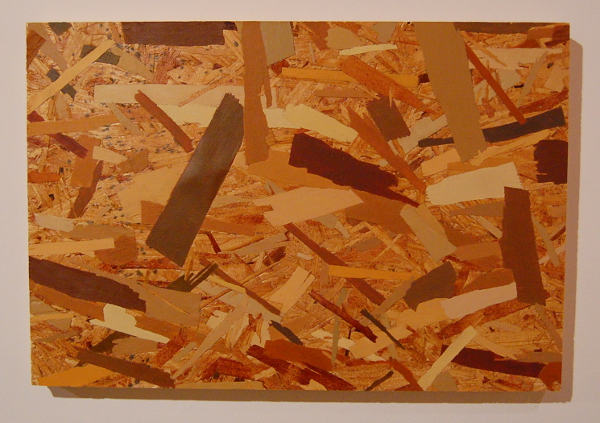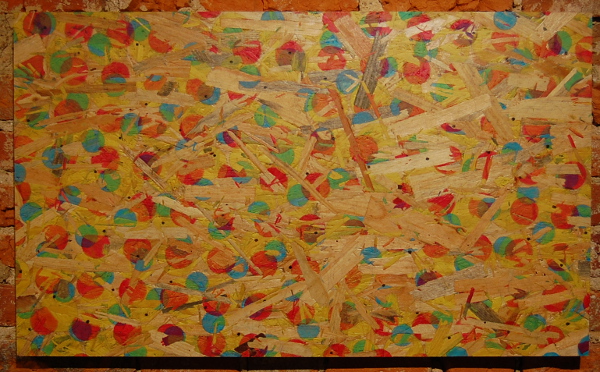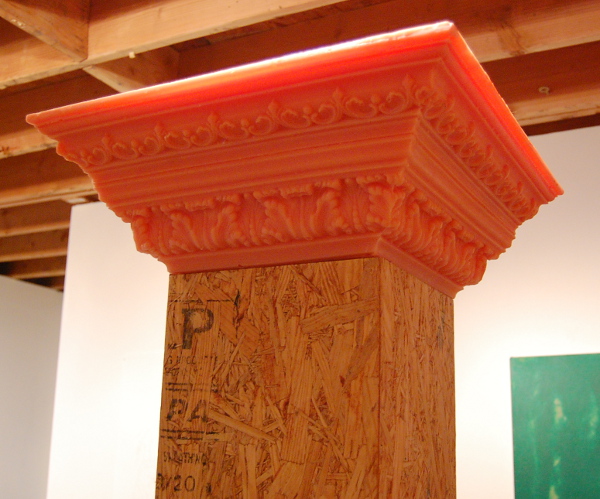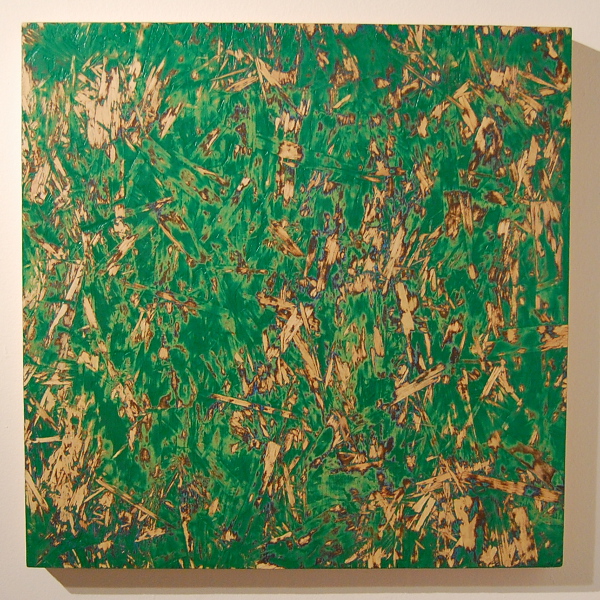
The unexpected allure of a prefab, mass produced world at Fjord
“They don’t make ’em like they used to…” is a phrase often uttered by tired idealists or anyone who waxes poetic about the benefits of real wood over particle board. It is worth noting that none of the people exhibiting work at Fjord this month really fit this description. Nick Van Zanten, Magali Hébert-Huot and Justin Hoekstra have assembled a show entitled “Autocomplete/Manual Delete,” which consists of prefab structures that are comprised mostly of raw materials that have been reworked into iterations of themselves.
Examining the systemic mass production and inanimate detachment of the substances that surround us on a daily basis, the artists here bond over OSB (oriented strand board) – that erratically assembled, mechanically glued plywood substitute that makes up, among other things, much of the interior of the Fjord space itself. Its instantly recognizable texture is at once organic and synthetic, a mash-up of rough, wooden bits casually flattened together into neat panels. As an aesthetic starting point, this engineering phenomenon contains so many layers of production and happenstance, separation and consolidation, that its humble purposes almost obscure its potential.
Directly confronting the OSB specter, Van Zanten reveals the haphazard arrangement of the substance by painstakingly detailing the individual chunks of wood with paint. In some, the color is complementary or true to reality, emphasizing the incongruity of applying expensive pigment to an otherwise cheap surface. Elsewhere, the artist is more liberal with color choices, utilizing bright neon colors and pastels to cover up the tan and brown shards beneath. He even dots one piece — “(CMYK) Of/On OSB” — with printed pixels that seem both at odds with their chaotic surroundings, yet anchored in place.
Nick Van Zanten, “(CMYK) Of/On OSB.”
One of the highlights of the show lingers in the back room like some cooling colander of fettuccine. Nick Van Zanten’s “1×2 Pile” consists of pool noodle-type foam cut to the dimensions of 1×2-inch boards, and then wrapped in spandex material printed with wood grain patterns. The result is a limp pile of planks that looks like someone might have overcooked their lumber.
Nick Van Zanten, “1x2s” and Justin Hoekstra, “You Say ‘Potatoh,’ I say ‘Dan Quayle.'”
With the addition of one actual board into the mix, the ruse is complete, all situated atop Justin Hoekstra’s machine-printed throw cover, entitled “You Say ‘Potatoh,’ I say ‘Dan Quayle,’” an original artwork digitally reproduced as a woven blanket. Without close inspection of the fraudulent boards, the floppy composition is a mind-bending experiment in surrealist architecture. Upon scrutiny, it breaks down into an exercise in observation and imitation.
Magali Hébert-Huot, “Untitled (Columns)” (detail).
If Van Zanten’s installation is a study in pretense, then Magali Hébert-Huot’s artworks are this show’s sincerity. Throughout the main exhibition space, tall, rectangular OSB columns thrust upwards toward the ceiling. They are not quite lovely but not ugly either. Their flat faces are some dusty construction site, yet their tops defy this rigidity. On their pinnacles, Greco-Roman inspired capitals wear leafy adornments, but diverge from their ancestors by way of their bright, candy-colored hues. These waxen capstones, other than looking vaguely delicious, would not make for good supports, as their malleable tops would certainly smash and distort under any real weight, and so they remain refreshingly free of burden.
Justin Hoekstra, “Spinach Pie with Flash 2.”
Justin Hoekstra’s paintings are more a subtractive sculpture than an additive painting. By applying washes of paint and then attacking the layers with an orbital sander, Hoekstra creates expressive marks with the power of a machine. In this context, the harsh edges and biological forms invoke the composition of particle board, and sometimes even reveal it underneath. Almost like an inversion of the clumsy industrial assembly of OSB, Hoekstra reveals the human element of machination by tearing through his very own marks to create severe reductions of otherwise mild-color field paintings. It is here that we find ourselves coming full circle enough to imagine the interlocking wood chips of manufactured boards as something appealing, even unique.
By tearing down and rebuilding the processes and products from automated factories with the wit and zest of handmade original artwork, we find alluring shapes and an unusual authenticity where we least expect it. The exhibit is on display through February 1.
Fjord is located at 2419 Frankford Ave., Philadelphia; [email protected]; fjordspace.com.
Recent Content
-
Artsarticle ·
-
Artsarticle ·
-
Artsarticle ·




